Hei Mahi MāraMātauranga Māori Māra Kai
Jul 6, 2012

A beginner’s guide to growing organic vegetables
nā Tremane Barr
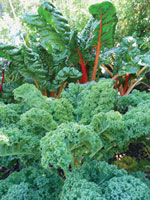
Kale and silverbeet winter vegetables
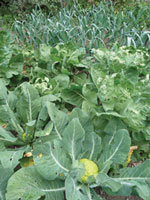
Broco-cauliflower, brussel sprouts and leeks
I have been involved with the ‘Building Māori Organic Land Use Project’ with Te Atawhai o Te Ao, an independent Māori research organisation. The project focused on interviewing a wide range of Māori with experience in māra kai to identify the traditional mātauranga and kaitiakitanga basis to Māori organics. This research identified that Māori organic practices are based on a practical approach of working within natural environmental cycles underpinned by a spiritual relationship between Māori, the atua and Papatūānuku. The research identified five main Māori cultural themes that encompass 11 key principles underpinning the traditional approach of Māori to what is now called organic māra kai practices. They can be grouped in this order:
Wairua (soul/spirit) and mauri (life force) are the indicators of soil fertility that can be seen, for example, in the health of the plants. Karakia is used to communicate and acknowledge the atua protecting and enhancing the māra and what it produces.
Whakapapa – Māramataka and Mātauranga
Whakapapa confirms one’s space as a gardener and is about looking after the genetic health of living organisms, for example, no genetic engineering. Mātauranga Māori underpins the understanding of working with the forces of nature that are encoded in maramataka and can be used to plan māra kai activities.
Rangatiratanga – He mahinga kai katoa and taonga
Rangatiratanga is about the authority to use the whenua and mahinga kai resources. The mahinga kai of the whenua (land), Tane (forests) and Tangaroa (the waterways and seas) are all seen as part of one whole holistic mahinga kai ecosystem – ‘ki uta ki tai’ (from the mountains to the sea). As such, all mahinga kai are viewed as taonga.
Tikanga – Rāhui
Tikanga encompasses the concepts of cultural practices and customs to provide a safe framework for working in a māra, which can traditionally encompass the use of such tools as rāhui.
Kaitiakitanga – He ringa raupā, manaakitanga, tapu and noa
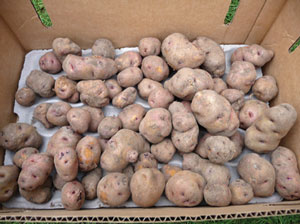
Old Ōtākou Riwai potatoes
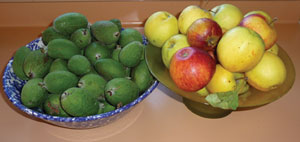
Feijoa and apple early winter harvest
Kaitiakitanga is about the physical hard work (he ringa raupā) that produces food from the māra, while the concepts of tapu and noa provide a cultural understanding of when certain practices are, and are not, appropriate. It is the practice of kaitiakitanga that makes it possible to provide manaakitanga to manuhiri at home, and on a marae, and is also the basis for the ‘kai hau kai’ traditions of Ngāi Tahu.
The holistic nature of this traditional cultural approach by Māori to organics is actually the key part of its strength. Each principle and practice reinforces all the others, and in this way confirms the innate traditional mātauranga Māori organic approach to environmental sustainability based on working naturally with Papatūānuku. The most important thing I learned from this research is to remember to incorporate karakia and māramataka when working in the māra to acknowledge that gardening is an act of co-creation between both the physical and non-physical sides of life. However, without the he ringa raupā as well, there won’t be much gained out of any māra.
One of the practical outputs of this research project is a beginner’s guide to establishing and maintaining your own māra kai called: Grow Your Own Kai by Lisa Talbot. This booklet provides a brief overview of the practical issues of establishing and maintaining an organic māra from a Māori perspective such as how to work with the soil, make compost, create your own worm farm, grow kūmara, rīwai, kamokamo, watakirihi and hue. It also provides a comprehensive maramataka based on the phases of the moon, highlighting the best times to undertake mahinga kai activities. Details on how to win a copy of this booklet are at the end of this article.
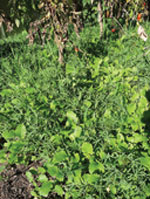
Lupin-mustard cover crop
About five years ago the field worker for the He Whenua Whakatipu project stumbled across some wild rīwai (potatoes) growing on the side of a hill in some scrub on the Otago Peninsula. The few he managed to salvage were very small, but he was able to grow them and now they have rebounded to grow quite big in the right soil. We suspect it was one of the original rīwai varieties brought into Te Waipounamu at time of first contact with Europeans in the early 1800s so is a real taonga variety. Unfortunately, the psyllid insect pest devastated this rīwai crop in the summer of 2010–11 and I only just managed to save a few tubers for growing on this past summer. In order to spread the risk, some Ngāi Tahu co-workers kindly offered to grow some in their Moeraki māra as well and these grew fabulously large in the rich soil they have there. They have given me some of their surplus to pass on to others who might want to grow this variety of rīwai taonga in their māra to help spread the risk of it dying out altogether. This is because the psyllid pest has continued its rampage this season in Canterbury and other parts of New Zealand, devastating potato crops. The more places it is grown the better, to minimise the chances that psyllids can destroy all crops.
To win a copy of Lisa Talbot’s booklet Growing Your Own Kai, answer this question: What farm management approach does Te Rūnanga o Wairewa Pūtahi (Te Pūtahi) farm follow? You can find the answer at the new Ahikā Kai website. Email your answer to [email protected].